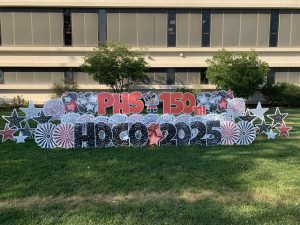Start brown bagging your lunch
Palatine High School serves lunch periods 3 through 6.
April 26, 2017
Pizza, cheeseburgers, chicken wraps, enchiladas…Palatine’s lunch menu is seemingly indistinguishable from a fast food dive.
That is, until it’s served on a plastic tray with 1-4 vegetable and fruit sides, an 8 oz. chocolate milk and a hot pretzel from the a lá carte, filled with cheeto orange artificial cheese product.
What makes it more complicated is the intense amount of government regulations and federal programs that meal went through to get to 1,150 students at Palatine High School who consume school lunches.
“I think the lunches are pretty good,” Palatine High School freshman Nicole Sobkowiak said. She took a second look at her cheeseburger, “I mean, they’re okay.”
Unfortunately, “okay” is about the highest compliment school lunches in the United States are going to get these days. One of the biggest struggles for many cafeterias is to prepare foods that students want to eat and that fit government regulations.
Most students are looking for pizza, nachos, pretzels, and the like. Making nachos with less than 200 mg of sodium and less than 35% of calories from fat is a nearly impossible feat when the entire dish is made of carbs that have been fried, glazed with salt, and smothered in cheese.
When I asked Deborah Madaj (who is in charge of the student food services at Palatine High School) what menu items had been removed in recent years due to harsher regulations it was clear that the entire repertoire had been modified.
“There would be too many things to list, so it’s easier to say that we now have specific guidelines on what we can serve,” head of student food services Deborah Madaj commented. “Everything we offer has to meet strict USDA restrictions.”
These restrictions haven’t always been around.
In 2010, a law was passed known as the Healthy, Hunger-Free Kids Act. It focuses on “improving child nutrition… [and] authorizes funding…for the USDA’s core child and nutrition programs,” according to the United States Department of Agriculture.
Such programs include the National School Lunch Program, the School Breakfast Program, the Summer Food Service Program, and a free after school snack program, which PHS proudly takes part in.
Advocating for the health of children in the United States was one of the core values of First Lady Michelle Obama, and President Barack Obama, who signed this bill.
Some of the regulations that school lunches now require as a result of this and other laws can be found at the Federal Register.
These place limitations on what foods can be served depending on what nutritional values they have, and what they are being served as (a lá carte, entreé, etc.), and they may explain why the nice cafeteria lady keeps making you take vegetable cups.
“I like the food, but I want the good cookies back,” freshman Leah Daly said. “Our school is too healthy.”
It is unrealistic to think that Daly is alone in her beliefs, as many students choose not to bring their lunch from home, and instead either buy from the cafeteria or purchase food from restaurants in close proximity to the school campus, such as Jimmy Johns.
And truthfully, it isn’t necessarily a bad idea to brown bag your lunch. After all, the USDA can’t regulate what you bring yourself whether that be a more nutritious choice or the contrary.
Bringing your own lunch means being in complete control of what goes into your body–a power that’s often underestimated.
Despite national efforts to make school lunches as healthy as possible, having access to a plethora of chips, ice cream bars, and chocolate chip cookies (even if they aren’t the “good” ones) is extremely enticing.
Bringing your own lunch helps with resisting these unhealthful temptations, and keeps your lunch healthier and tastier overall.
“A homemade lunch is typically also healthier because you can better control the portions and ingredients,” Associate Business Editor Jillian Berman, who works at The Huffington Post, said. She had sought advice from David Just, a behavioral economist at Cornell University, and found that “[p]acking your lunch in advance also helps workers avoid using hunger as an excuse to buy something terrible.”
Aside from a little extra work the night before, Leah Bradley, a sophomore at Palatine High School, finds this to be entirely true.
Bradley’s lunch consists of nearly the same thing everyday: a sandwich, chips, a granola bar, and water.
“I always bring my own lunch to school because I can pack whatever I want,” sophomore Leah Bradley said. “I never have to worry about not liking what’s on the school menu or throwing away food I didn’t want.”
In regards to taste, well, it’s hard to beat a Rib-e-que sandwich from the school cafeteria, but having the freedom to customize your own menu can not only be more enjoyable, but better for the planet.
Chances are, if you aren’t so keen on that Rib-e-que sandwich I mentioned earlier, you aren’t going to finish it. This means that you will contribute to the 40% of uneaten food thrown out in the U.S. each year.
“The consequences of food waste do not stop there,” Executive Editor of Impact and Innovation at The Huffington Post Jo Confino said, in a summary of a report by the Food and Agriculture Organization. “It annually generates 3.3 billion tons of greenhouse gases worldwide.”
Making healthy and environmentally friendly decisions at lunch is just one way that we can exercise our power as individuals for the benefit of our bodies and the planet.
So, if you’re a regular Jimmy John’s delivery buyer, or an a lá carte connoisseur, I challenge you this: Pack yourself a turkey sandwich tomorrow with carrot sticks or apple slices, and trust me, you’ll be glad you did.








